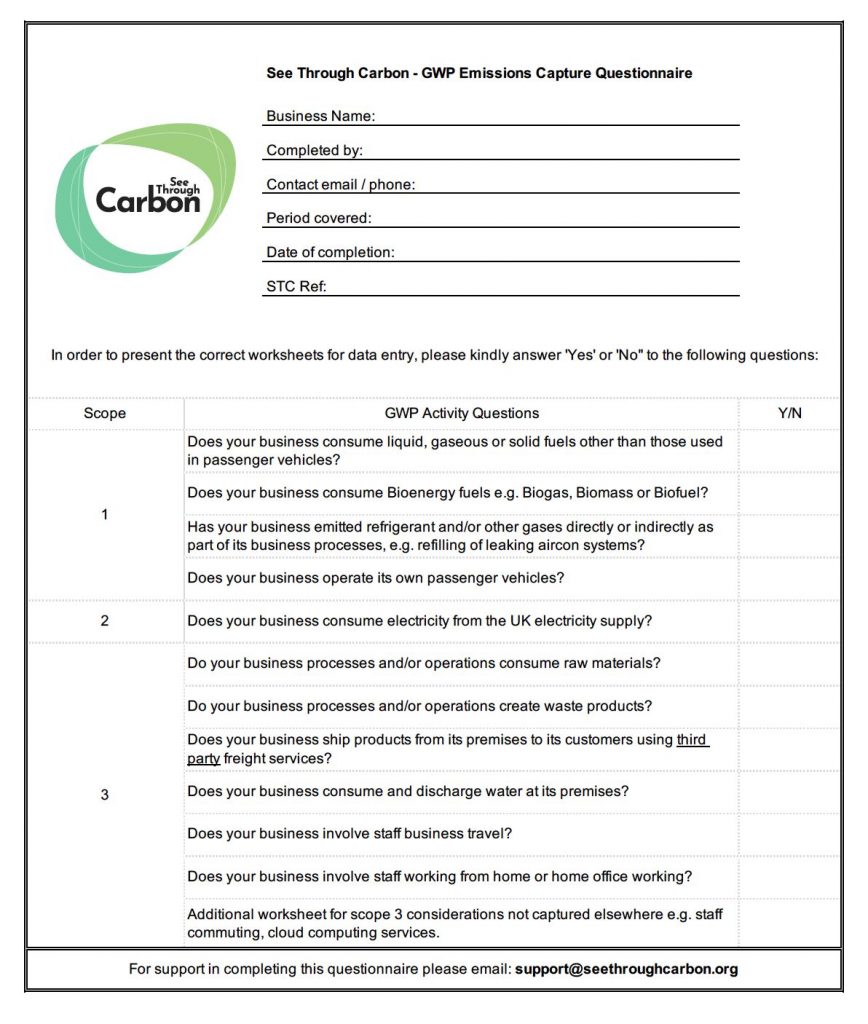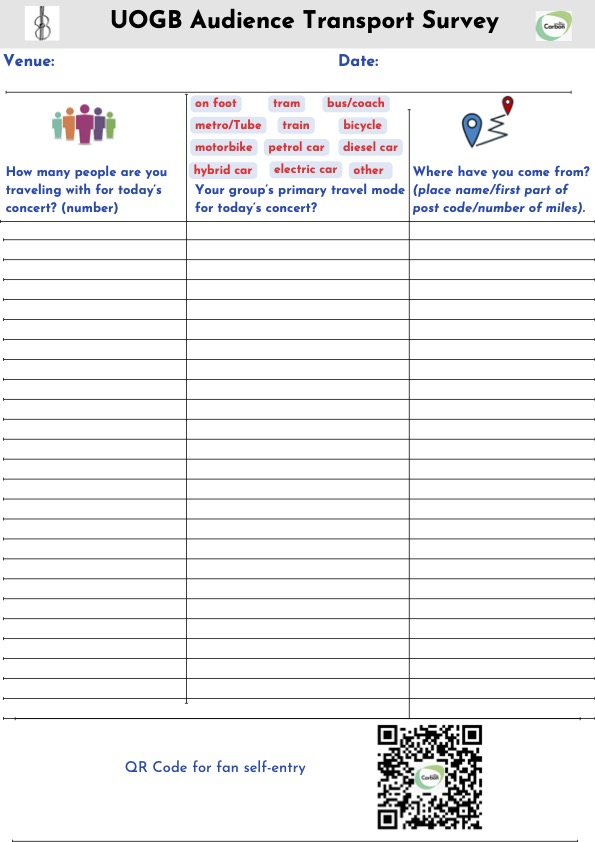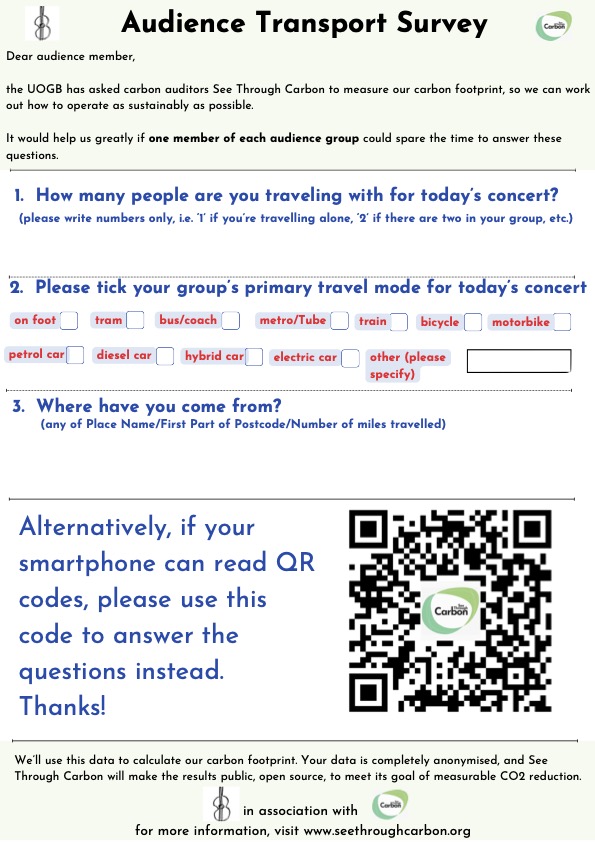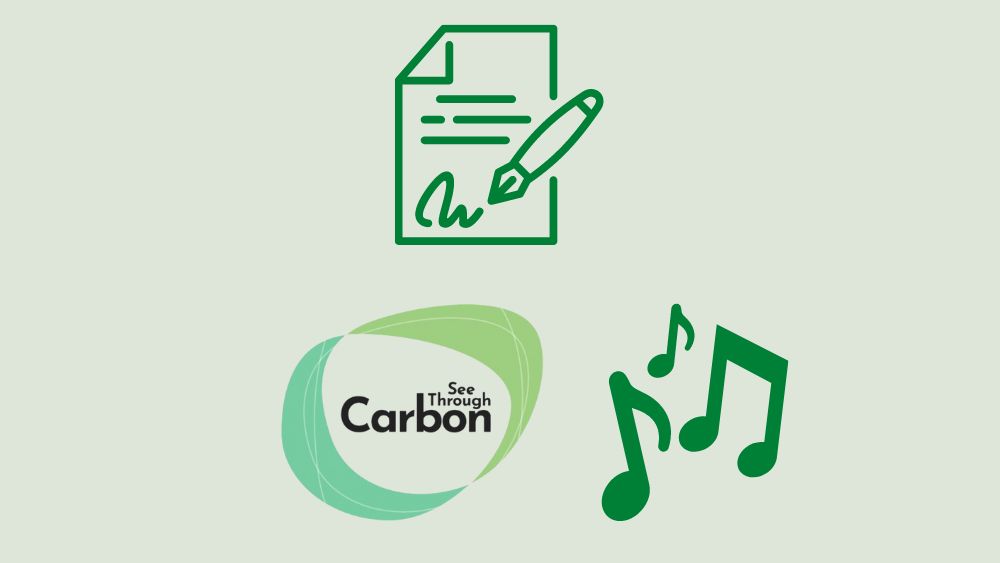How live music venues, bands, promoters and other stakeholders can apply for See Through Carbon’s ground-breaking pilot to help music measurably reduce carbon
See Through Carbon’s has 7 Pilot schemes for its innovative carbon auditing standard. This is the 5th of 9 articles introducing Pilot 2
- Why See Through Carbon Matters
- What See Through Carbon Is
- What Carbon Auditing Is
- What See Through Carbon’s 7 Pilot Schemes Do
- Why See Through Carbon Chose UK Live Music for Pilot 2
- How See Through Carbon Pilot 2: UK Live Music Works
- The Benefits of participating in Pilot 2: UK Live Music
- How To Participate in Pilot 2: UK Live Music
- Pilot 2: UK Live Music FAQs
These articles all presume:
- We urgently need to reduce carbon
- This requires accurate, comprehensive carbon footprint measurement
Application Process
When Pilot 2 is complete, See Through Carbon will make the aggregated data publicly available. This will create a unique, detailed open-source database to help all live events, whether concerts , sports, rallies or prayer meetings, measure and reduce their carbon emissions.
As explained elsewhere, Pilot participants will benefit by being able to compare their own data with the aggregate dataset, and See Through Carbon has a limited number of Pilot slots for live concert industry stakeholders. This article explains how to apply for the pilot if you’re one of the following entities:
- Venue
- Band/Act
- Promoter
- Ticket agent
- Record label
- Bus/Coach company
As far as possible the pilot slots will be allocated on a first-come, first-served basis, but will take into account balancing different types of stakeholders to provide the most comprehensive mix of perspectives possible.
Emails application details are at the bottom of this article. Before applying, please consider:
- requirements for your free carbon footprint calculation and list of carbon-reducing solutions
- how you might collect the Transport Survey data
- which data protection model you’d like to apply for the Transport Survey
- the secure automated data transfer system that’s best suited to your set-up
Free Carbon Audit & Consultancy

Accurate carbon audits usually cost venues and bands hundreds of pounds. Expert carbon-reducing consultancy usually costs thousands.
See Through Carbon provides both for free.
- Audit: All pilot Participants will receive a carbon audit conducted to the. highest professional standards by STC’s global team of specialists, working pro bono. This will be presented in an accessible, interactive pie chart, showing your business’s emission sources.
- Consultancy: All pilot Participants will receive a bespoke list of carbon-busting solutions, each with a carbon ‘price tag’ estimating the amount of emissions each solution would reduce.
STC’s carbon audit is like a financial audit, but much quicker and simpler.
- Client Code: Once your application is approved, STC will issue you with your unique Client Reference Code for the carbon audit, and a unique QR code for the Audience Transport Survey.
- Data Entry: Your Client Reference Code will provide access to the STC data collection form. This generic form prompts you to enter the non-financial information required to calculate the emissions of your basic activities. Cost (inc. tax) $0.00
- Carbon Audit: STC’s team of auditors, with expertise in the particular scope of your business (which varies depending on the nature of your industry) may follow up with queries on the data entered (for example, looking for outlier data resulting from missing or adding a zero), and/or ask you for additional information relevant to your particular business (for Pilot 2, live concerts).
- Carbon Consultancy: When STC’s auditors are satisfied with the quantity and quality of information provided, they calculate your bespoke pie chart, and provide a list of solutions for your main sources of emissions.
- DataViz: STC provides convenient data visualisations showing your total net emissions, with detailed breakdowns showing calculations and methodology. Like annual financial statements at Companies House, this information will appear on a shareable public page. Cost (inc. tax) $0.00
- Audience Transport Surveys: Participants supplying Audience Transport Survey data (favoured for the Pilot phase) provide ongoing automated data to create STC’s audience travel database, and view their business model through a carbon lens. See below for details.
- Corroborating Direct Carbon-Related Data: Participants provide anonymised data for events for which audience survey data is collected, in order to verify statistically reliable correlations between existing ticket data (the number of tickets bought per credit card transaction and the first part of the billing address post code) and the real-world data collected by the transport surveys. Once enough data has been acquired to establish a reliable correlation between the predictive ticket sale data and the real-world transport surveys, STC will no longer need the latter, and can base estimates on the former. Cost (inc. tax) $0.00
- Supplementary Indirect Carbon-Related Data: Venues provide bar sales data, and bands merchandise sales data, to match with the corresponding baseline carbon footprint data. Having established this baseline data, Pilot 2 will compare these financial outcomes with events where carbon-reducing measures like the provision of coaches for audiences takes place, to determine whether such services make money, lose money, or break even, as well as measuring their carbon reduction. This commercially sensitive information is confidential, so does not appear on individual participants’ public pages, and only apperas publicly in anonymised aggregate form – though Pilot participants can benefit from knowing how their individual data compares to their industry average. Cost (inc. tax) $0.00
Why the need for Audience Transport Surveys?
In parallel with the offer of free carbon audits and consulting for music stakeholder entities, Pilot 2 is conducting a series of Audience Transport Surveys in collaboration with participating clients.
This survey project is separate, in the sense that this it unique to Pilot 2, as it’s not required for the other pilots, but linked in the sense that it’s hard for STC (or anyone) to claim to be giving an accurate carbon footprint of a live concert without an evidence-based, rational basis for estimating what’s likely to be the biggest single source of emissions.
Available research indicates that for live events, like concerts, audience transport is likely to be the biggest slice of any carbon footprint pie chart.
This research, however, isn’t detailed or systematic enough for professional auditors to make accurate, evidence-based estimates without conducting time-consuming, labour-intensive transport surveys for each event. Ideally, auditors would be able to look up appropriate conversion factors in a well-researched table of reliably pre-calculated estimates.
Car-makers Scope 3, for example, would include some of the emissions used to make the steel that arrives at their factory gate – which can be looked up in an established table. Likewise clothes manufacturers with their raw materials. When STC calculates the emissions for different types of vehicle for the Transport Survey (petrol car/diesel car/hybrid car/electric car etc.) it refers to a well-established body of pre-calculated evidence to used standard conversion factors that reflect the real-world emissions for each category.
Common sense tells us that the number of people walking (zero emissions) to a concert by a recently-formed teenage folk trio playing above a city centre pub is likely to be much lower that the number of people driving long distances to see Taylor Swift at a national stadium – but there’s no reliable basis on which to calculate by how much.
Currently, no such reference table exists for live concerts, reflecting variables such as venue size, venue location, the scope of the band’s appeal, and many other factors.
Which is why Pilot 2 is collecting this data, which in aggregate will provide and comprehensive, robust, systematic basis for estimating fan transport emissions for individual venues or bands. In a sense, this means we’re building the bicycle as we ride it, but this is necessary because no one has yet invented the derailleur gear system.
Hence the need for Pilot 2’s Audience Transport Survey.
Methodology – three ways
STC only needs 3 questions to calculate is the data controller (i.e. the participant chooses ‘Agent’ status – see below) this means doing audience transport surveys consisting of 3 simple questions to help STC calculate accurate Scope 3 conversion factors. (How many in your group? Mode of transport? Where from?) over a period of weeks.
See Through Carbon Pilot 2 uses three data collection methods to acquire Audience Transport Survey data.
Please note there’s no need to select only one method. Indeed, comparing the response rates from different methods on different audiences – or even the same audience at the same event – provides valuable and interesting data insights itself.

‘Clipboard’ Method
The ‘gold standard’ method – face-to-face humans at the concert on the night surveying fans as they arrive/leave or during the intermission – provides the highest quality data due to:
- Reliability: respondents are less likely to modify their answers when asked a neutral question by a fellow-human (online surveys tend to produce fewer responses, more frivolous responses, or responses tailored to putative ‘right’ answers).
- Accuracy: answers are more likely to reflect actual mode of transport on the day, rather than intent (asking the intended mode of transport at point of sale is convenient and low-friction, but people tend not to think too hard about transport when they buy the tickets, or plans may change due to on-the-day variables like weather).
The number of clipboard collectors required depends greatly on the layout of the venue, and size of the audience, but STC volunteers have achieved 50%+ response rates with 3-5 surveyors.
With only 3 simple questions, most responses only take a few seconds. With the average number of people travelling together being between 2 and 3, and the survey only requiring one person from each group to respond, high response rates can be achieved with relative ease.
Audience flow impact is minimal if conducted outside, or in spacious foyers, or while people are queueing.
Venue staff will have other duties, but task can be carried out by volunteers from the community, or affiliated to the venue.
‘Card’ Method

Audience members are invited to self-report by filling in a printed flyer or card, like the one pictured in our How It Works article.
This requires less staffing, and is especially suitable for elder audiences unfamiliar with QR codes but used to filling in forms.
Response rates can be greatly boosted if the performers the audience have paid to see announce the survey on stage, and encourage their fans to fill in the form at the intermission or as they leave (placing the forms at the bars and merchandise tables also helps both venue and band).
STC has achieved response rates of 50%+ using this method alone. Like the clipboard method, the data has to be manually entered into a spreadsheet (as only one member per travel group is required to respond, manual data entry for an audience of 500 only takes around 30 minutes).
‘QR Code Method
This is the most friction-free method – a QR code linking to a form containing the 3 survey questions is simply displayed at the venue.
This method can also be highly effective, especially with younger audiences more accustomed to QR codes, and response rates can be greatly improved if audience members are asked/encouraged to participate by venue staff as they check their tickets or enter/exit the venue, and by perfomers on stage.
As the process is entirely automated, there’s no need for manual data entry.
Data Protection – two models
Once registered, Pilot 2 participants can choose how they wish to provide their Audience Transport Survey data. Both methods are fully compliant with GDPR and other data protection protocols.
‘Agent’ model
- STC is responsible for GDPR/ICO compliance as the ‘data processor’ and ‘data controller.
- STC only collects the minimum data required to calculate the carbon footprint of an audience for a particular event.
- Using a unique QR code, the venues routinely conduct transport surveys on behalf of STC.
- STC benefits by gathering data to meet its goal of measurably reducing carbon, venue benefits by this plus gathering its own unique transport dataset to mutual benefit (see below).
- STC only stores and retains non-personal anonymised data, which it will make publicly available in aggregate form.
‘Principal’ model
The participating Pilot venue is responsible for GDPR/ICO compliance as the ‘data processor’ and ‘data controller. Any venue already collecting email lists, for example, should already have this in place.
The venue incorporates STC’s transport questionnaire into their own form – as it will almost certainly already have the answers to Q1 (implicit in the number of people in any booking) and Q3 (from the credit card billing address), they only actually have to add one question, Q2, regarding the mode of transport.
As the Pilot 2 database grows, consistent, nuanced, granular correlations can be established between the predictive data from credit card ticket sales, and real-world ‘gold standard’ surveys. Once established, this database will form the evidence-based foundation of See Through Carbon’s estimates of the carbon footprints of future events.
These estimates/conversion factors are not currently available, making the accurate measurement of concert’s carbon footprint impossible. STC will make its conversion factors transparent and open source, so any live event providers can improve their emissions measurement.
Data Transfer System – many options
STC’s tech team can help Pilot participants set up automated transfer of the transport-only non-personal data from your own datasets, on all major survey platforms, e.g. Google Analytics, Quantrics, SurveyMonkey, MailChimp, Excel etc.
For venues or bands choosing to conduct their own surveys, and incorporate STC’s questions into theirs, STC provides step-by-step guides as to how to automate the process on all major ticket platforms, e.g. Eventbrite, Ticketmaster, Ticketsource, Billetto, Fienta, Yapsody, Spectrix and Universe.
Whichever reporting system you prefer, both participants and STC benefit by automating the process as far as possible.
We’ll send an email explaining how it all works, including a unique QR code for each venue linking to our database, for data collection.
How to apply
- To register your interest, email Pilot2.music@seethroughcarbon.org
- For further enquiries, email info@seethroughcarbon.org with the subject line ‘Pilot 2’
Thank you for your interest and consideration.

